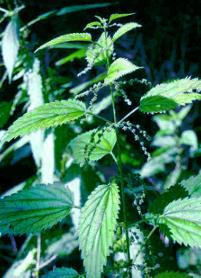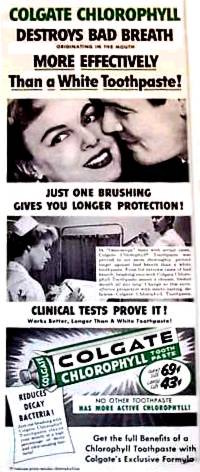 Chlorophyll is what gives plants their green pigment. It is also responsible for channeling the sun's rays into chemical energy for photosynthesis in all plants. Photosynthesis is the transformation of carbon dioxide and water into useful carbohydrates and oxygen. In human beings, chlorophyll is one of the few substances that pulls more oxygen into the cells, while simultaneously protecting all of the cells from oxidative (free radical) damage.
Chlorophyll is what gives plants their green pigment. It is also responsible for channeling the sun's rays into chemical energy for photosynthesis in all plants. Photosynthesis is the transformation of carbon dioxide and water into useful carbohydrates and oxygen. In human beings, chlorophyll is one of the few substances that pulls more oxygen into the cells, while simultaneously protecting all of the cells from oxidative (free radical) damage.
During the 1950's, it was used in certain U.S. toothpastes, due to it being only toxic to harmful bacteria and yeasts, such as candida. It was a remarkable breath freshener that also stimulated gum repair in people with gum disease. The Colgate company had its own line of chlorophyll toothpaste. There was also Palmolive's chlorophyll soap for enhanced beauty and improved skin complexion. These products worked better than their modern equivalents, because they came before products were required to use toxic chemicals to preserve them for extremely long shelf life. It was before the poisoning of the public was required by official regulations.
There was a period when scientists actually believed that chlorophyll could not be absorbed into the human body, since no trace of toxicity could be detected from it. Modern chemists in the food, pharmaceutical and cosmetics industries have sadly become that unaccustomed to non-toxic substances. When a controlled study discovered chlorophyll inside the blood plasma of those supplementing with it, serious studies into the health benefits of chlorophyll finally began. Nevertheless, there still remains gross misunderstandings of the absorption and bio-availability of chlorophyll today.
 Chlorophyll has the rare tendency of binding with certain carcinogenic chemicals, preventing them from causing damage, and aiding their excretion from the body. This includes aflatoxin-B1, known for causing liver cancer, benzo[a]pyrene, known for causing lung cancers, dioxins, and components of typical tobacco products. These facets of chlorophyll are still being researched. Chlorophyll should eventually be recognized as the major cancer preventative that it is, because it reduces the cellular damage done by all carcinogens, including radiation. Moreover, chlorophyll actually removes benzene from the body, which is produced in proteins whenever they are exposed to radiation.
Chlorophyll has the rare tendency of binding with certain carcinogenic chemicals, preventing them from causing damage, and aiding their excretion from the body. This includes aflatoxin-B1, known for causing liver cancer, benzo[a]pyrene, known for causing lung cancers, dioxins, and components of typical tobacco products. These facets of chlorophyll are still being researched. Chlorophyll should eventually be recognized as the major cancer preventative that it is, because it reduces the cellular damage done by all carcinogens, including radiation. Moreover, chlorophyll actually removes benzene from the body, which is produced in proteins whenever they are exposed to radiation.
There are studies ongoing about chlorophyll's ability to prevent liver cancers in subjects who have had aflatoxin exposure. Aflatoxin-B1 is produced by a fungus which lives on moldy grains, beans and corn. There are some areas where this exposure is unavoidable, so human studies have been conducted in these Chinese regions. So far, it appears that chlorophyll supplementation provides massive protection to those who consume that carcinogen. Conclusive studies are expected to take about 20 years, but there is enough research already available for any reasonable person to see an unmistakable trend.
Supplemental Chlorophyll
Chlorophyll is present in all green vegetables, and thus it could be obtained through diet if we were to eat enough vegetables. However, the great majority of people never get enough vegetables in their diets. This trend, in combination with deficient soils that no longer produce nutrient-dense foods, generates the modern need for supplementation. Chlorophyll is best purchased as a liquid concentrate. Multiple drops may be added to drinks or swallowed straight. Supplementation with chlorophyll provides a long-lasting boost of energy, by somehow increasing the overall oxygenation of cells to enhance respiration, but this process is not well understood.
Almost every bodily process is somehow related to oxygen usage. As a result, chlorophyll has shown to help its users resist not only cancers, but also diabetes and heart disease. According to the Linus Pauling Institute, chlorophyll has historically been used to speed the recovery of bruising, and as an internal deodorant. Chlorophyll is sometimes mixed in ointments, and applied topically to wounds, but we recommend against eliminating bruises with pure chlorophyll drops, because concentrated chlorophyll stains skin a greenish-black. Nevertheless, chlorophyll was well recognized as the most effective way to quickly eliminate bruising in the mid-twentieth century, likely due to its high concentration of copper.
Despite 50 years of study, chlorophyll has never shown any toxic effects. Through the act of providing more oxygen to the cells, chlorophyll increases energy, improves concentration, boosts the immune system, aids the body to cleanse itself, and prevents some cancers. It contains magnesium and copper, which are minerals that the overwhelming majority of Americans are deficient in. Magnesium deficiencies lead to heart attacks, migraines, depression, insomnia, and irritability. The copper is necessary for a body to utilize zinc.
Most people should supplement with small amount of chlorophyll daily, for optimal benefit. There are no side-effects, and it is essential for the proper functioning of the body. It is fairly tasteless when mixed with juices. The improved energy and concentration derived from it are remarkable. Kids will love the fact that chlorophyll drops will make their mouths green when placed directly on the tongue, which is the fastest way to absorb it. The concentrated form is more natural and effective than weaker competing solutions with additives. A person using chlorophyll will feel the difference in energy, which happens from almost immediately to hours later. We are not aware of exactly which factors influence its delay in activity. People with Wilson's Disease should not use chlorophyll, due to their inability to properly excrete copper.
Related Articles:
Quick Tip: Answering Questions about Radiation from Japan and Potassium Iodide
A New Method of Poisoning Us With Radiation: 'High Efficiency' Light Bulbs
Shielding Yourself From Radiation and Dangerous Radioactive Exposure From Cancer Patient Emissions
The F.D.A.'s Push For Radioactive ("Irradiated") Foods
More Radiation Poisoning Coming Soon to a Hospital Near You
JAMA Admits that Chemo and Radiation are Likely to Cause Death
Radioactive Airport Body Scanners and Official Child Molestation Procedures
